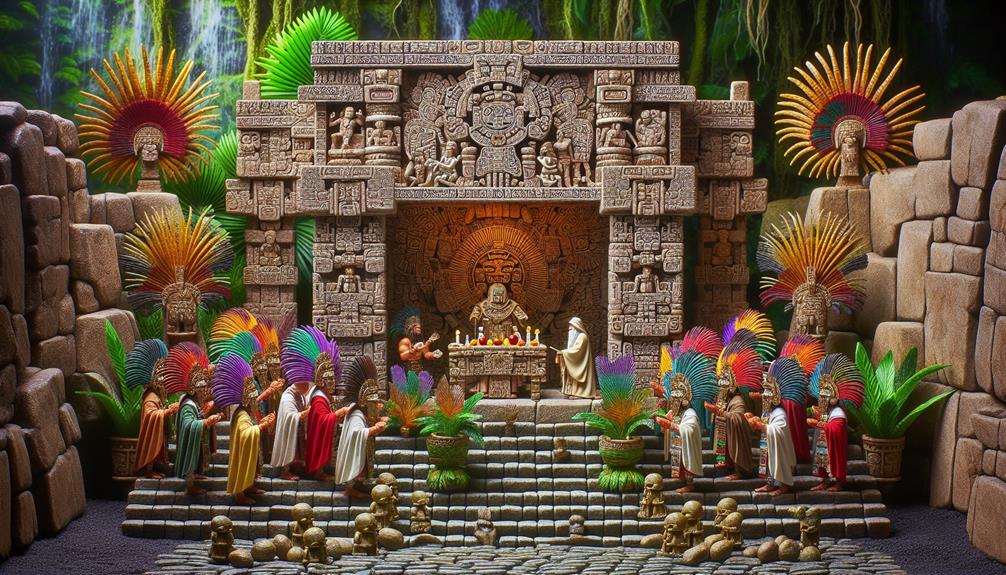You’re about to explore the intricate world of the Aztec civilization, where a rich tapestry of gods and rituals defined daily life. Imagine standing in the heart of Tenochtitlú¡n, surrounded by vibrant festivals honoring deities like Huitzilopochtli and Quetzalcoatl, each representing crucial aspects of existence. As you uncover the social hierarchies and the significance of these ceremonies, you’ll start to see how deeply interconnected belief and society were. But what drives such devotion, and how did these practices shape the fate of a civilization? The answers may surprise you.

The Aztec Pantheon
The Aztec pantheon is a vibrant tapestry of gods and goddesses, each representing different aspects of life, nature, and the cosmos that shaped the beliefs and practices of this extraordinary civilization.
You’ll encounter deities like Huitzilopochtli, the fierce god of war, who guided the Aztecs in their conquests and was central to their identity. Then there’s Quetzalcoatl, the feathered serpent, symbolizing wisdom and culture, often associated with creation and the arts.
As you probe deeper, you’ll discover Tlaloc, the rain god, whose tears brought nourishment to the earth, emphasizing the importance of agriculture. Don’t forget Xipe Totec, the god of agricultural renewal and rebirth, celebrated for his transformative powers.
Each deity had distinct attributes and stories, weaving a complex narrative that influenced daily life.
The Aztecs viewed their gods as active participants in their world, demanding respect and offerings. Understanding this pantheon allows you to grasp the intricate relationship the Aztecs had with their environment and the divine—an essential cornerstone of their civilization.
The reverence they held for these deities reveals much about their values, priorities, and the interconnectedness of their society.
Rituals and Festivals
Celebrating a rich tapestry of life and death, Aztec rituals and festivals were essential to maintaining harmony with their gods and the cosmos. These events weren’t just grand spectacles; they were deeply spiritual experiences that involved the whole community.
Picture vibrant processions filled with music and dancing, where participants adorned themselves in elaborate costumes, embodying deities and historical figures. You’d witness offerings of food, flowers, and even precious items laid at the feet of temples, each gesture a plea for divine favor.
The most significant festival, the Feast of the Sun, honored Huitzilopochtli, the god of war and the sun. During this time, you’d see elaborate ceremonies, including ritual sacrifices, believed to nourish the gods and guarantee the sun’s continued journey across the sky.
Moreover, each month brought its own unique celebrations, reflecting the agricultural calendar and seasonal changes. You could join in the joy of the Tlaxochimaco festival, where families would create colorful floral arrangements, celebrating the bounty of the earth.
Through these rituals, the Aztecs connected with their spiritual world, reinforcing their identity and purpose in the intricate web of existence.
Social Structure and Hierarchy
In the intricate tapestry of Aztec society, a clearly defined social structure and hierarchy shaped daily life and governance, influencing everything from trade to religious practices. At the top, you’d find the emperor, or tlatoani, revered as a divine figure responsible for maintaining cosmic balance. Just below him, the nobility held significant power, including priests and Military leaders.
These individuals played pivotal roles in both governance and religious rituals, often acting as intermediaries between the gods and the people.
As you descend the social ladder, you’d encounter the merchants, who were essential to the economy, engaging in trade across vast networks.
Below them, artisans and skilled laborers contributed to the cultural richness of the civilization, creating intricate crafts and art. At the bottom of the hierarchy were the commoners, who worked the land and provided essential services.
Slaves, often prisoners of war, occupied a unique position, with some able to buy their freedom.
This intricate hierarchy not only dictated individual roles but also Reinforced the interconnectedness of Aztec society, where every class played a part in sustaining the empire’s grandeur.
Continue Your Journey: Exploring the Depths of Aztec Civilization
The intricate tapestry of Aztec civilization, with its gods, rituals, and societal structures, continues to captivate and inspire. Their profound cultural legacy offers endless avenues for exploration and understanding. To further immerse yourself in the fascinating world of the Aztecs, we invite you to read a detailed article on the aztec. This comprehensive piece delves deeper into their complex society, religious practices, and the pantheon of deities that shaped their worldview.